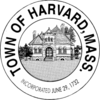Harvard, Massachusetts facts for kids
Quick facts for kids
Harvard, Massachusetts
|
|||
|---|---|---|---|
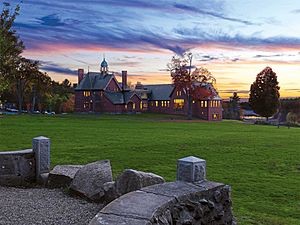
The renovated library, established in 1856
|
|||
|
|||
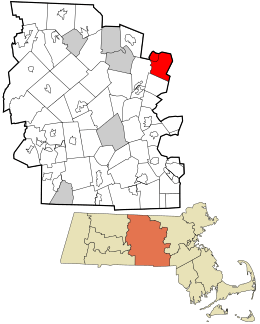
Location in Worcester County and the state of Massachusetts.
|
|||
| Country | United States | ||
| State | Massachusetts | ||
| County | Worcester | ||
| Settled | 1658 | ||
| Incorporated | 1732 | ||
| Government | |||
| • Type | Open town meeting | ||
| Area | |||
| • Total | 27.0 sq mi (69.9 km2) | ||
| • Land | 26.4 sq mi (68.3 km2) | ||
| • Water | 0.6 sq mi (1.6 km2) | ||
| Elevation | 420 ft (128 m) | ||
| Population
(2020)
|
|||
| • Total | 6,851 | ||
| • Density | 253.7/sq mi (98.01/km2) | ||
| Time zone | UTC-5 (Eastern) | ||
| • Summer (DST) | UTC-4 (Eastern) | ||
| ZIP code |
01451
|
||
| Area code(s) | 351 / 978 | ||
| FIPS code | 25-28950 | ||
| GNIS feature ID | 0619482 | ||
| Website | www.harvard.ma.us | ||
Harvard is a town in Worcester County, Massachusetts, United States. It is about 25 miles northwest of Boston. The town is mostly bordered by major roads like I-495 to the east and Route 2 to the north.
Harvard was first settled in 1658 as a farming community. It became an official town in 1732. Over the years, Harvard has been home to unique communities. These include the Harvard Shaker Village and Fruitlands, a place where people tried to live in a special way.
The town is also home to St. Benedict Abbey, a traditional Catholic monastery. For many years, Harvard was home to Harvard University's Oak Ridge Observatory. This was once the best-equipped observatory in the Eastern United States. Today, Harvard is a quiet, residential town known for its good public schools. In 2020, about 6,851 people lived here.
Contents
History of Harvard Town
Europeans first settled in the area that is now Harvard in the 1600s. They built homes along a road connecting Lancaster and Groton. This road was officially created in 1658. The land was bought from Native American leaders Sholan and George Tahanto.
Not many people lived there until after King Philip's War. This war caused a lot of damage to nearby towns like Groton and Lancaster. Over the next 50 years, more people moved to the area. By 1732, there were enough people to support a church. A new town was formed from parts of Lancaster, Groton, and Stow. The new town had to build a church and find a minister within two years.
It's not certain how the town got its name. However, the Willard family, who were early settlers, had strong ties to Harvard College. According to The Harvard Crimson, Josiah Willard named the town after the college he attended. The first minister was Rev. John Seccombe, who served from 1733 to 1757.
In 1734, Harvard had five main areas or villages. These were Oak Hill, Bare Hill, Still River, Old Mill, and Shabikin. Shabikin is now part of Devens.
One important early business in Harvard was the Benjamin Ball Pencil Company. They made some of the first writing pencils in the United States. They operated from 1830 to 1860 in the Old Mill area. Even with some manufacturing, Harvard's economy was mostly based on agriculture until the mid-1900s. You can still see this history in the many apple orchards. These orchards produce lots of apple products, especially apple cider. Today, Harvard is mostly a "bedroom community." This means many people live there and travel to work in Boston and its nearby towns.
Harvard has a fairly calm history. But it has attracted several unique communities. These groups have added interesting stories to its past.
The Shakers: A Unique Community
One part of Harvard is home to the Harvard Shaker Village. This was a religious community that believed in living a simple, shared life. During a time of religious change, some Harvard residents left the main Protestant church. They were led by Shadrack Ireland. In 1769, they built a house known as the Square House.
After Ireland died in 1778, the Shaker leader Mother Ann Lee met with this group in 1781. The group then joined her community, called the United Society of Believers in Christ's Second Appearing.
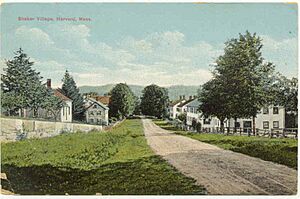
This was the first Shaker settlement in Massachusetts. It was the second Shaker settlement in the entire United States. The Harvard Shaker Village Historic District includes areas around Shaker Road, South Shaker Road, and Maple Lane. At its largest, the Shakers owned about 2,000 acres of land in Harvard.
By 1890, the Harvard Shaker community had shrunk to less than 40 people. At its peak in the 1850s, there were about 200 members. In 1917, the Harvard Shaker Village closed and its land was sold. Only one Shaker building is open to the public, at Fruitlands Museum. The other buildings are now privately owned homes.

Across the country, 19 Shaker communities were started in the 1700s and 1800s. Most were in the northeastern United States. Shaker communities were known for their simple buildings and furniture. They reached their highest number of members in the 1840s and 1850s.
The Shakers believed in celibacy, meaning they did not marry or have children. To keep their numbers up, they always needed new people to join. As the Industrial Revolution brought more job opportunities in the mid-1800s, fewer people chose to join the Shaker community. Today, only one Shaker community remains open. It is run by the last few Shakers at Sabbathday Lake Shaker Village in New Gloucester, Maine.
Fruitlands: An Experiment in Living
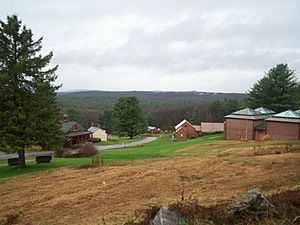
In June 1843, Amos Bronson Alcott moved his family to Harvard. His ten-year-old daughter, Louisa May Alcott, came with him. He and Charles Lane tried to create a special farm called Fruitlands. This farm was on Prospect Hill in Harvard. It was an experiment in transcendentalist living, where people tried to live simply and be self-sufficient.
This experimental community only lasted seven months, closing in January 1844. Fruitlands was named this "because the inhabitants hoped to live off the fruits of the land, purchasing nothing from the outside world." Famous thinkers like Henry David Thoreau and Ralph Waldo Emerson visited Fruitlands. Louisa May Alcott later used her experiences at Fruitlands as inspiration for her famous novel Little Women.
Clara Endicott Sears owned a summer home called The Pergolas on Prospect Hill. She helped restore Fruitlands and opened it as a museum in 1914. On the museum grounds, there is also a Shaker house. Sears moved it there from Harvard's Shaker Village in 1920. It was the first Shaker museum ever created in the United States. Sears also opened a gallery at the museum dedicated to Native American history. She became interested in Native Americans after finding Nipmuck arrowheads on her property. The Nipmuck Indians had called Prospect Hill "Makamacheckamucks."
Originally, Sears' Fruitlands property was about 458 acres. But in 1939, 248 acres were taken by the government to expand Fort Devens. As of 2010, that land is now part of the Oxbow National Wildlife Refuge.
St. Benedict Abbey: A Place of Prayer
In Still River, a part of Harvard, there is an abbey of Benedictine monks. These monks came from a group called the St. Benedict Center. They focus on saying Mass in both English and Latin. They also chant the Divine Office in Latin. Their current leader is Abbot Marc Crilly, who was chosen on May 15, 2021.
Geography and Nature
The town of Harvard covers about 27.0 square miles. Most of this (26.4 square miles) is land, and a small part (0.6 square miles) is water.
The eastern part of Harvard is on a large ridge. In 1931, Harvard College built the Oak Ridge Observatory here. It is at an elevation of 609 feet. This is the highest point between Mount Wachusett and the ocean.
Harvard has many woods, rolling hills, open fields, and wetlands. Besides many streams and brooks, there is Bare Hill Pond. This is a 320-acre lake with a town beach, a dock, and several small islands. It is a central and important spot in the town.
Population and People
| Historical population | ||
|---|---|---|
| Year | Pop. | ±% |
| 1850 | 1,630 | — |
| 1860 | 1,507 | −7.5% |
| 1870 | 1,341 | −11.0% |
| 1880 | 1,253 | −6.6% |
| 1890 | 1,095 | −12.6% |
| 1900 | 1,139 | +4.0% |
| 1910 | 1,034 | −9.2% |
| 1920 | 2,546 | +146.2% |
| 1930 | 987 | −61.2% |
| 1940 | 1,790 | +81.4% |
| 1950 | 3,983 | +122.5% |
| 1960 | 2,563 | −35.7% |
| 1970 | 12,494 | +387.5% |
| 1980 | 12,170 | −2.6% |
| 1990 | 12,329 | +1.3% |
| 2000 | 5,981 | −51.5% |
| 2010 | 6,520 | +9.0% |
| 2020 | 6,851 | +5.1% |
| 2023* | 6,928 | +1.1% |
| * = population estimate. Source: United States Census records and Population Estimates Program data. |
||
In 2000, there were 5,981 people living in Harvard. There were 1,809 households and 1,494 families. About 44.7% of households had children under 18 living with them. Most households (73.4%) were married couples living together.
The population was spread out by age. About 26.6% were under 18. About 32.3% were between 45 and 64 years old. The average age was 41 years.
The average income for a household in Harvard was $117,934. For a family, it was $139,352. Only a small number of families (0.5%) and people (2.0%) lived below the poverty line.
The number of people in Harvard dropped from 1990 to 2000. This was because Fort Devens, a U.S. military base, closed in 1996. Many military people and their families who lived there moved away. Much of the Fort Devens land has now been changed for civilian use. This was done by MassDevelopment.
Arts and Community Life
Harvard's public library opened in 1856. The town's official seal shows the old public library building on The Common. This was before it was renovated and the front steps were removed. In 2008, Harvard spent about $487,470 on its public library. This was about $81 per person. The library has been renovated many times since then.
Education in Harvard
Harvard has three public schools. Hildreth Elementary School is in the center of town. The Bromfield School is a middle and high school. These schools are highly rated in Massachusetts and across the country.
In Devens, there is the Francis W. Parker Charter School. In Still River, there is the Immaculate Heart Of Mary. This is a private traditional Catholic school for students in Grades 1–12.
When the town built the current Bromfield School building, it chose not to combine its school system with other towns. This was despite efforts from the Massachusetts School Building Authority. This authority helps fund new school buildings and renovations.
Famous People from Harvard
Many interesting people have lived in Harvard:
- Amos Bronson Alcott, a teacher and writer who started Fruitlands.
- Louisa May Alcott, a famous novelist and daughter of Amos Alcott.
- Cornelius Atherton, an inventor and steel maker. He built muskets for the Revolutionary Army.
- Tabitha Babbitt, a tool maker.
- T. A. Barron, author of fantasy novels.
- Jonathan Edwards, a musician.
- William Emerson, a minister and father of Ralph Waldo Emerson.
- Fannie Farmer, a well-known cookbook author.
- Donald Featherstone, who created the pink plastic flamingo lawn ornament.
- Levi Hutchins, a clockmaker who invented the American alarm clock.
- Lynn Jennings, an Olympic runner.
- Keir O'Donnell, an actor who graduated from Bromfield School in 1996.
- Joseph Palmer, known for his long beard.
- Willard Van Orman Quine, an American philosopher.
- Clara Endicott Sears, who founded Fruitlands Museum.
- Ted Sizer, a leader in educational reform.
- Gary K. Wolf, the creator of Roger Rabbit.
See also
 In Spanish: Harvard (Massachusetts) para niños
In Spanish: Harvard (Massachusetts) para niños



